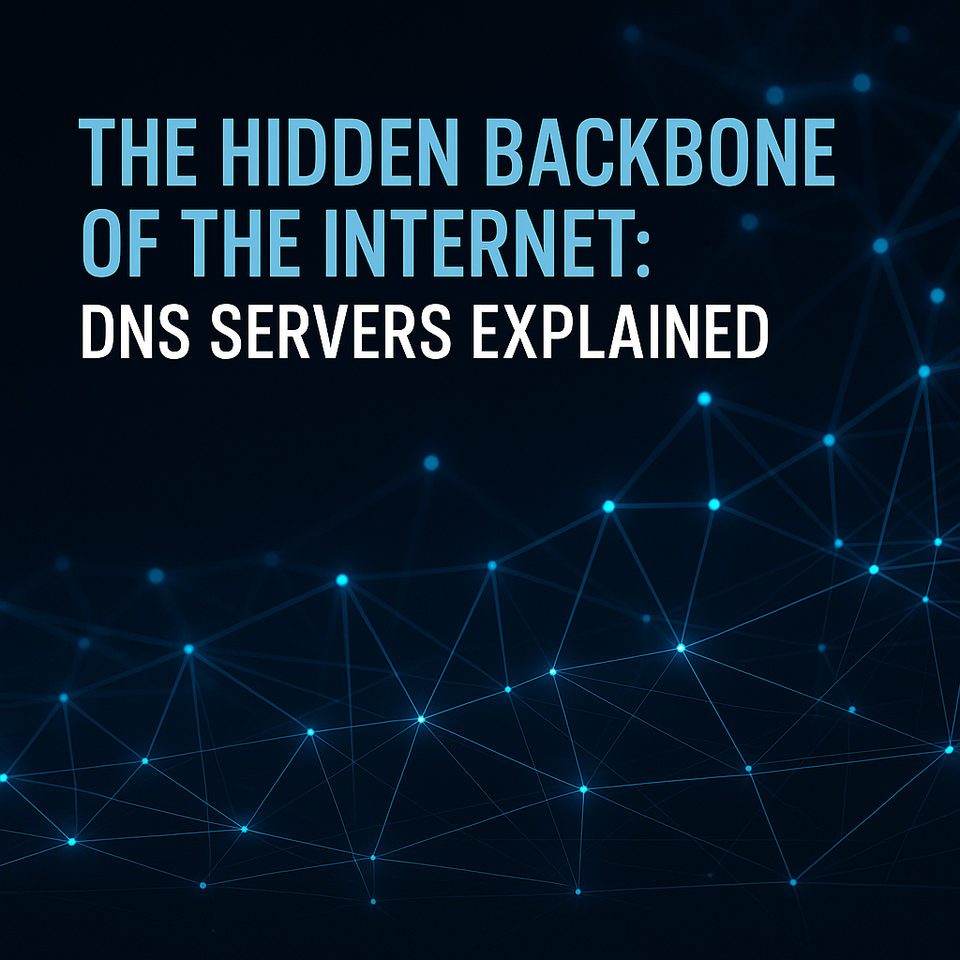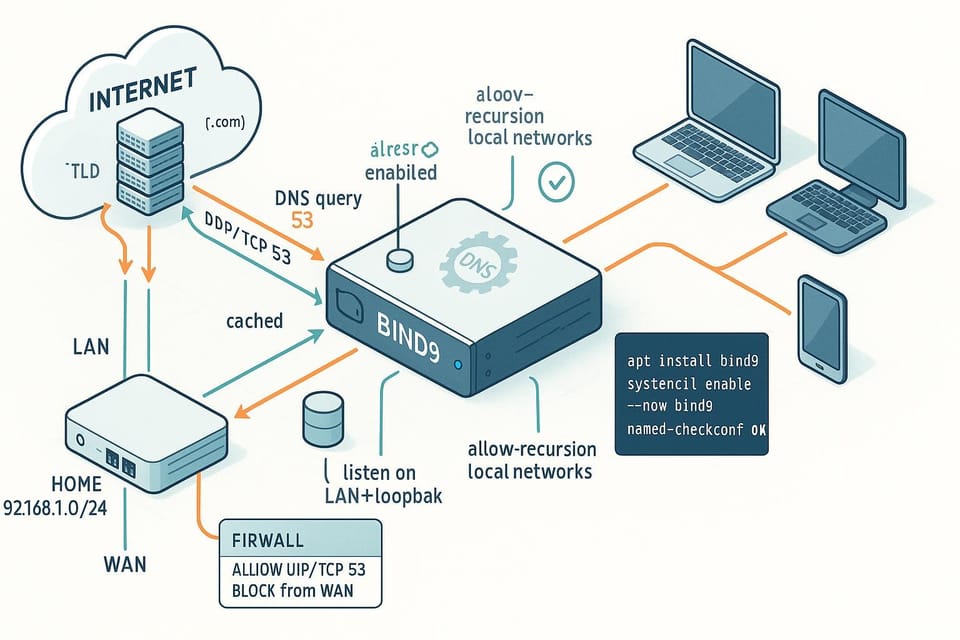DNS Explained: Complete Guide to Domain Name System, How It Works, and Common DNS Server Issues
Discover everything about DNS—the internet's phone book that translates domain names into IP addresses.

Introduction to DNS: The Internet's Phone Book
The Domain Name System (DNS) is one of the foundational technologies that makes the internet accessible and user-friendly. Often described as the "phone book of the internet," DNS translates human-readable domain names like www.example.com into machine-readable IP addresses such as 192.0.2.1. Without DNS, we would need to memorize complex numerical addresses to visit our favorite websites.
In this comprehensive guide, we'll explore everything about DNS—from its fundamental architecture to advanced troubleshooting techniques for DNS server issues that IT professionals encounter daily.
What is DNS and Why Does It Matter?
Understanding the DNS Fundamentals
DNS (Domain Name System) is a hierarchical and decentralized naming system for computers, services, or other resources connected to the Internet or a private network. It associates various information with domain names assigned to each of the participating entities.
Key DNS Functions:
- Translates domain names to IP addresses (forward lookup)
- Translates IP addresses to domain names (reverse lookup)
- Routes email using Mail Exchange (MX) records
- Provides service discovery through SRV records
- Enables domain verification via TXT records
- Supports load balancing and redundancy
The History and Evolution of DNS
Before DNS existed (pre-1983), the internet used a simple text file called HOSTS.TXT maintained by Stanford Research Institute. As the internet grew, this centralized system became unsustainable. Paul Mockapetris invented DNS in 1983, introducing a distributed, hierarchical system that could scale with the internet's explosive growth.
How DNS Works: The Complete Process
The DNS Resolution Process Step-by-Step
When you type a website address into your browser, a complex series of events occurs in milliseconds:
1. Local Cache Check
Your computer first checks its local DNS cache to see if it recently visited the domain. If found, it uses the cached IP address immediately.
2. Recursive DNS Query
If not cached locally, your computer sends a query to a recursive DNS resolver (usually provided by your ISP or a service like Google DNS or Cloudflare DNS).
3. Root Name Server Query
The recursive resolver queries one of the 13 root name server systems, which respond with the address of the appropriate Top-Level Domain (TLD) server (.com, .org, .net, etc.).
4. TLD Name Server Query
The resolver then queries the TLD server, which responds with the address of the authoritative name server for the specific domain.
5. Authoritative Name Server Query
The resolver queries the authoritative name server, which responds with the IP address for the requested domain.
6. Response to Client
The recursive resolver returns the IP address to your computer, which then connects to the web server at that address.
7. Caching
The IP address is cached at multiple levels (browser, operating system, recursive resolver) to speed up future requests.
DNS Query Types Explained
Recursive Query: The DNS client requires the DNS server to respond with either the requested resource record or an error message if the resolver can't find the record.
Iterative Query: The DNS server responds with the best answer it can provide or a referral to another DNS server that might have better information.
Non-recursive Query: This occurs when the DNS resolver queries a DNS server for a record that it has authority over or that exists in its cache.
DNS Architecture and Components
DNS Name Servers: Types and Roles
1. Root Name Servers
The highest level of the DNS hierarchy, there are 13 sets of root servers (labeled A through M) operated by different organizations worldwide. They don't contain information about specific domains but direct queries to the appropriate TLD servers.
2. TLD (Top-Level Domain) Name Servers
These servers maintain information for all domain names sharing a common domain extension (.com, .org, .edu, etc.). Generic TLD (gTLD) servers handle extensions like .com, while country-code TLD (ccTLD) servers handle country-specific extensions like .uk or .de.
3. Authoritative Name Servers
These are the final authority for a specific domain. They contain DNS records for domains and provide definitive answers to queries about those domains.
4. Recursive Resolvers (DNS Resolvers)
Acting as intermediaries between clients and name servers, recursive resolvers perform the work of querying multiple name servers to resolve a domain name. Most users' DNS queries go through recursive resolvers provided by ISPs or third-party DNS services.
DNS Records Types: A Complete Overview
A Record (Address Record)
Maps a domain name to an IPv4 address (e.g., example.com → 192.0.2.1)
AAAA Record
Maps a domain name to an IPv6 address (e.g., example.com → 2001:0db8:85a3::8a2e:0370:7334)
CNAME Record (Canonical Name)
Creates an alias from one domain name to another (e.g., www.example.com → example.com)
MX Record (Mail Exchange)
Specifies mail servers responsible for accepting email for the domain
TXT Record
Contains text information for various purposes, including domain verification, SPF, DKIM, and DMARC for email security
NS Record (Name Server)
Specifies which servers are authoritative for the domain
SOA Record (Start of Authority)
Contains administrative information about the domain including the primary name server, email of the domain administrator, and timing parameters
PTR Record (Pointer)
Used for reverse DNS lookups, mapping IP addresses back to domain names
SRV Record (Service)
Specifies location of services like SIP, XMPP, or LDAP
CAA Record (Certification Authority Authorization)
Specifies which certificate authorities are permitted to issue certificates for the domain
Common DNS Server Issues and Troubleshooting
1. DNS Server Not Responding
Symptoms:
- "DNS server not responding" error messages
- Inability to load any websites despite having internet connectivity
- Long delays before timeout errors
Common Causes:
- Network connectivity issues
- Incorrect DNS server configuration
- DNS server overload or downtime
- Firewall blocking DNS queries (port 53)
- Router or modem problems
Solutions:
# Flush DNS cache (Windows)
ipconfig /flushdns
# Flush DNS cache (macOS)
sudo dscacheutil -flushcache; sudo killall -HUP mDNSResponder
# Flush DNS cache (Linux)
sudo systemd-resolve --flush-caches
# Test DNS connectivity
nslookup google.com
dig google.com
2. DNS Cache Poisoning (DNS Spoofing)
What It Is:
A security exploit where corrupt DNS data is introduced into the DNS resolver's cache, causing the name server to return incorrect IP addresses and redirecting traffic to malicious sites.
Prevention Measures:
- Implement DNSSEC (DNS Security Extensions)
- Use randomized source ports for DNS queries
- Limit DNS cache retention time
- Deploy DNS filtering and monitoring
- Keep DNS software updated
3. DNS Propagation Delays
The Issue:
When DNS records are updated, changes don't appear instantly worldwide due to caching and propagation time.
Understanding TTL (Time To Live):
TTL values determine how long DNS records are cached. Lower TTL values result in faster propagation but increased DNS query load.
Best Practices:
- Lower TTL values 24-48 hours before planned DNS changes
- Verify changes using online DNS propagation checkers
- Use multiple DNS checking tools from different geographic locations
- Allow 24-48 hours for complete global propagation
4. DNS Amplification Attacks (DDoS)
Attack Method:
Attackers exploit open DNS resolvers to amplify their traffic volume, using small queries to generate large responses directed at target victims.
Mitigation Strategies:
- Configure DNS servers to respond only to legitimate clients
- Implement rate limiting
- Deploy anycast routing for DDoS protection
- Use DNS security services like Cloudflare or AWS Shield
- Disable recursion on authoritative name servers
5. NXDOMAIN and DNS Resolution Failures
NXDOMAIN (Non-Existent Domain) Errors:
Indicates that the queried domain name doesn't exist in the DNS.
Common Causes:
- Typos in domain names
- Domain expiration
- Incorrect DNS configuration
- Missing DNS records
- DNS propagation in progress
Troubleshooting Steps:
# Check if domain exists
nslookup example.com
# Query specific DNS server
nslookup example.com 8.8.8.8
# Detailed DNS information
dig example.com ANY
# Trace DNS resolution path
dig +trace example.com
6. DNS Timeout Issues
Symptoms:
Slow website loading, intermittent connectivity, applications hanging while resolving names.
Causes and Solutions:
Network Latency:
- Choose geographically closer DNS servers
- Switch to faster DNS providers (Google DNS: 8.8.8.8, Cloudflare: 1.1.1.1)
DNS Server Overload:
- Implement load balancing across multiple DNS servers
- Scale DNS infrastructure
- Use CDN services with integrated DNS
Misconfigured Timeout Values:
- Adjust DNS client timeout settings
- Configure appropriate retry attempts
7. Split-Brain DNS Problems
What Is Split-Brain DNS:
A configuration where internal and external DNS servers provide different answers for the same domain, typically for security or network optimization.
Common Issues:
- Incorrect zone configuration causing wrong responses
- Synchronization problems between internal and external zones
- VPN users getting wrong DNS responses
Solutions:
- Carefully plan and document DNS architecture
- Use DNS views or conditional forwarding
- Implement proper testing procedures
- Maintain separate zone files with clear distinctions
8. Reverse DNS Issues
Importance of Reverse DNS:
Critical for email delivery, security verification, and logging purposes.
Common Problems:
- Missing PTR records causing email rejection
- Mismatched forward and reverse DNS entries
- Multiple PTR records for single IP
Resolution:
- Ensure PTR records match forward DNS entries
- Contact hosting provider or ISP to configure PTR records
- Verify using reverse DNS lookup tools
Advanced DNS Concepts
DNSSEC: DNS Security Extensions
What DNSSEC Provides:
DNSSEC adds cryptographic signatures to DNS data, allowing DNS resolvers to verify that responses haven't been tampered with and actually come from authoritative sources.
DNSSEC Components:
- RRSIG (Resource Record Signature): Contains cryptographic signatures
- DNSKEY: Public key used to verify signatures
- DS (Delegation Signer): Establishes chain of trust
- NSEC/NSEC3: Provides authenticated denial of existence
Implementation Challenges:
- Increased DNS response sizes
- Additional computational overhead
- Key management complexity
- Incomplete adoption across the internet
DNS over HTTPS (DoH) and DNS over TLS (DoT)
Traditional DNS Privacy Issues:
Standard DNS queries are sent in plain text, allowing ISPs, network administrators, and attackers to monitor browsing activities.
DNS over HTTPS (DoH):
- Encrypts DNS queries within HTTPS traffic
- Uses port 443 (standard HTTPS port)
- Harder to distinguish from regular web traffic
- Supported by browsers like Firefox and Chrome
DNS over TLS (DoT):
- Encrypts DNS queries using TLS protocol
- Uses dedicated port 853
- Easier to identify and manage DNS traffic
- Supported by Android 9+ and many DNS servers
Privacy Benefits:
- Prevents DNS query snooping
- Protects against man-in-the-middle attacks
- Reduces targeted advertising based on DNS data
- Bypasses DNS-based censorship
Anycast DNS
How Anycast Works:
Multiple servers share the same IP address in different geographic locations. Network routing directs users to the nearest server automatically.
Benefits:
- Improved performance through geographic proximity
- Built-in redundancy and fault tolerance
- DDoS attack mitigation
- Reduced latency
Major Providers Using Anycast:
- Cloudflare
- Google Public DNS
- OpenDNS
- Quad9
DNS Performance Optimization
Choosing the Right DNS Provider
Factors to Consider:
- Latency: Response time significantly impacts browsing speed
- Reliability: Uptime and redundancy measures
- Security: Protection against threats and privacy features
- Features: Filtering, logging, custom configurations
- Geographic Coverage: Server locations worldwide
Popular Public DNS Providers:
Google Public DNS (8.8.8.8, 8.8.4.4)
- Fast and reliable
- Extensive global infrastructure
- Basic security features
- No content filtering
Cloudflare DNS (1.1.1.1, 1.0.0.1)
- Privacy-focused (doesn't log personal data)
- Very fast performance
- DNSSEC validation
- Malware blocking available (1.1.1.2)
OpenDNS (208.67.222.222, 208.67.220.220)
- Content filtering options
- Phishing protection
- Customizable blocking
- Detailed logging and statistics
Quad9 (9.9.9.9)
- Security-focused with threat blocking
- Privacy-respecting
- Free service
- DNSSEC validation
DNS Caching Strategies
Multi-Level Caching:
- Browser cache (typically 60 seconds)
- Operating system cache
- Router cache
- ISP recursive resolver cache
Optimizing Cache Settings:
- Set appropriate TTL values based on change frequency
- Lower TTL before planned changes, raise after
- Implement cache warming for critical domains
- Monitor cache hit rates
DNS Load Balancing
Round-Robin DNS:
Multiple A records for a single domain distribute traffic across servers.
Advantages:
- Simple implementation
- No additional hardware required
- Cost-effective
Limitations:
- No health checking
- Doesn't account for server load
- Cache timing issues
Advanced Solutions:
- GeoDNS: Routes based on user geographic location
- Weighted load balancing: Distributes based on capacity
- Health-check-based routing: Automatically removes failed servers
DNS Management Best Practices
1. Documentation and Organization
- Maintain detailed DNS record inventory
- Document change procedures
- Use consistent naming conventions
- Implement version control for zone files
2. Redundancy and High Availability
- Use multiple DNS providers (primary and secondary)
- Implement geographic distribution
- Configure failover mechanisms
- Regularly test disaster recovery procedures
3. Security Hardening
- Restrict zone transfers to authorized servers only
- Disable recursion on authoritative name servers
- Implement rate limiting
- Enable DNSSEC where possible
- Regular security audits and updates
- Monitor for unusual query patterns
4. Monitoring and Alerting
Key Metrics to Monitor:
- Query response times
- Query volume and patterns
- Server availability and uptime
- DNS resolution errors
- Cache hit rates
- Security events
Recommended Tools:
- DNSPerf for performance testing
- DNSViz for DNSSEC visualization
- Zabbix or Nagios for monitoring
- Wireshark for packet analysis
5. Change Management
- Test DNS changes in staging environments
- Schedule changes during low-traffic periods
- Maintain rollback procedures
- Communicate changes to stakeholders
- Verify changes across multiple resolvers
DNS in Cloud Environments
AWS Route 53
Key Features:
- Highly available and scalable DNS service
- Domain registration
- Health checking and failover
- Traffic flow policies
- Integration with other AWS services
- Support for alias records
Use Cases:
- Hosting zone for domain management
- DNS-based load balancing
- GeoDNS routing
- Disaster recovery scenarios
Azure DNS
Features:
- Integration with Azure services
- Anycast network infrastructure
- RBAC (Role-Based Access Control)
- High availability SLA
- Private DNS zones for VNets
Google Cloud DNS
Capabilities:
- Managed authoritative DNS service
- Low latency with global presence
- DNSSEC support
- Private managed zones
- DNS forwarding and peering
Cloudflare DNS
Benefits:
- Fastest DNS resolver (1.1.1.1)
- Free tier available
- DDoS protection included
- Built-in WAF capabilities
- Analytics and insights
DNS Troubleshooting Tools
Command-Line Tools
nslookup
# Basic query
nslookup example.com
# Query specific record type
nslookup -type=MX example.com
# Query specific DNS server
nslookup example.com 8.8.8.8
dig (Domain Information Groper)
# Standard query
dig example.com
# Query specific record type
dig example.com MX
# Trace resolution path
dig +trace example.com
# Short answer only
dig example.com +short
# Reverse DNS lookup
dig -x 192.0.2.1
host
# Simple lookup
host example.com
# Verbose output
host -v example.com
# Specific record type
host -t MX example.com
Online DNS Tools
- DNS Checker: Verify DNS propagation globally
- MXToolbox: Comprehensive DNS and email testing
- IntoDNS: DNS health checks and reports
- WhatsMyDNS: Global DNS propagation checker
- DNSViz: DNSSEC visualization
- ViewDNS.info: Multiple DNS-related tools
Network Analysis Tools
Wireshark:
Filter DNS traffic: udp.port == 53 or tcp.port == 53
Analyze DNS queries and responses in detail
tcpdump:
# Capture DNS traffic
sudo tcpdump -i any port 53
# Save to file for analysis
sudo tcpdump -i any port 53 -w dns-capture.pcap
DNS and SEO: The Connection
How DNS Affects SEO
1. Website Speed:
Fast DNS resolution reduces overall page load time, a confirmed Google ranking factor.
2. Uptime and Reliability:
DNS failures cause website downtime, negatively impacting rankings and user experience.
3. Server Location:
GeoDNS can serve users from geographically closer servers, improving performance and local SEO.
4. Mobile Performance:
DNS performance is especially critical for mobile users on slower networks.
DNS Best Practices for SEO
- Use Fast, Reliable DNS Providers: Minimize resolution time
- Implement Redundancy: Prevent downtime from DNS failures
- Optimize TTL Values: Balance between performance and flexibility
- Enable DNS Prefetching: Help browsers resolve domains earlier
- Monitor DNS Performance: Track and address issues quickly
- Use CDN with Smart DNS: Improve global performance
DNS Prefetching for Web Performance
<!-- DNS prefetch for external resources -->
<link rel="dns-prefetch" href="//fonts.googleapis.com">
<link rel="dns-prefetch" href="//cdn.example.com">
<link rel="dns-prefetch" href="//analytics.example.com">
This technique instructs browsers to perform DNS resolution in the background before resources are needed, reducing latency.
The Future of DNS
Emerging Technologies
DNS over QUIC (DoQ):
Combines encryption benefits with improved performance through QUIC protocol's features.
Oblivious DNS over HTTPS (ODoH):
Adds additional privacy layer by separating query content from client identity.
Encrypted Client Hello (ECH):
Prevents exposure of server name during TLS handshake, complementing encrypted DNS.
IPv6 and DNS
As IPv6 adoption grows, DNS must handle longer AAAA records and dual-stack environments efficiently. Considerations include:
- Increased DNS response sizes
- Happy Eyeballs algorithm for trying IPv4 and IPv6 simultaneously
- Reverse DNS zones for IPv6 addresses
AI and Machine Learning in DNS
Emerging applications include:
- Predictive DNS caching based on usage patterns
- Automated threat detection in DNS queries
- Intelligent traffic routing optimization
- Anomaly detection for security purposes
Conclusion
The Domain Name System is fundamental infrastructure that enables the internet as we know it. Understanding DNS—from basic resolution processes to complex troubleshooting scenarios—is essential for IT professionals, web developers, system administrators, and anyone managing online presence.
Key takeaways:
- DNS translates human-readable names to IP addresses through a hierarchical, distributed system
- Multiple DNS record types serve different purposes from web hosting to email delivery
- Common DNS issues include server unavailability, cache poisoning, propagation delays, and DDoS attacks
- Security enhancements like DNSSEC, DoH, and DoT are increasingly important
- Performance optimization through provider selection, caching, and load balancing directly impacts user experience
- Proper DNS management requires documentation, monitoring, security hardening, and testing
- DNS affects SEO through site speed, reliability, and geographic performance
As the internet evolves, DNS continues to adapt with new security, privacy, and performance features. Staying informed about DNS best practices and emerging technologies ensures your infrastructure remains robust, secure, and optimized for the modern web.
Whether you're troubleshooting DNS server issues, implementing DNSSEC, optimizing for performance, or simply trying to understand how your domain name reaches users worldwide, this comprehensive guide provides the foundation for DNS mastery.
Related Resources:
- IANA Root Zone Database
- ICANN DNS Security Resources
- RFC 1034 and 1035 (DNS Specifications)
- DNS-OARC (DNS Operations, Analysis, and Research Center)
- Your DNS provider's documentation
Regular DNS maintenance, security monitoring, and performance optimization ensure reliable service delivery and positive user experiences across your web properties.
Read the complete DNS guide with advanced troubleshooting techniques and best practices at dargslan.com




